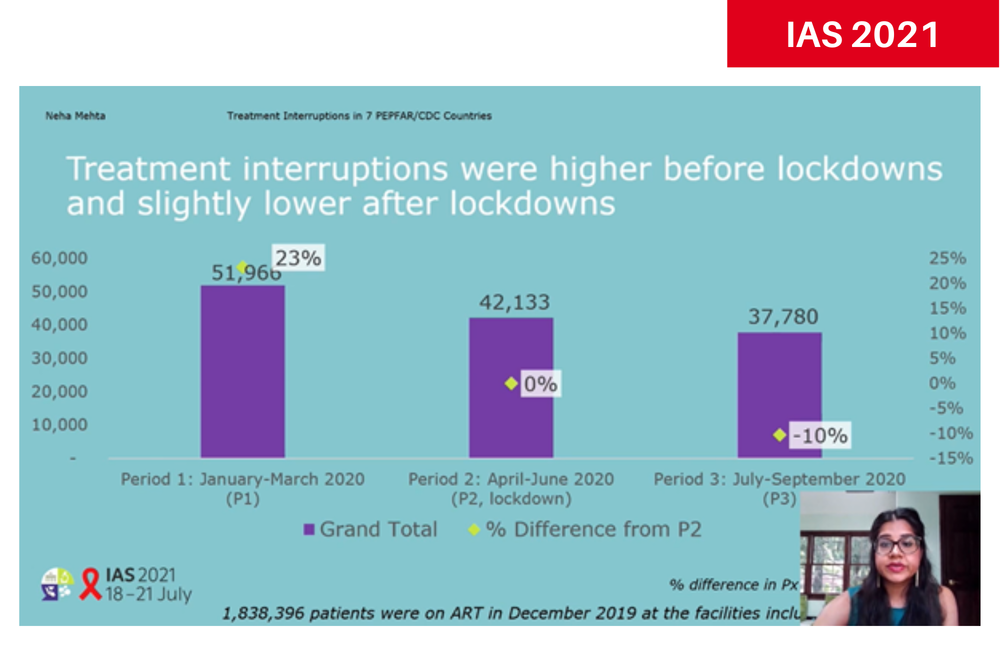
Fewer people living with HIV in six sub-Saharan African countries experienced interruptions to their HIV treatment during and after COVID-19-related lockdowns than before the pandemic hit, according to a PEPFAR study presented to the 11th International AIDS Society Conference on HIV Science (IAS 2021) today.
Early modelling of the impact of COVID-19 predicted that people living with HIV would struggle to access their treatment due to national lockdowns, restricted travel, and overwhelmed healthcare systems. These studies warned that treatment disruption could lead to a doubling in HIV-related excess deaths.
A team of researchers from sub-Saharan Africa and the US led by Neha Mehta of the US Centers for Disease Control and Prevention wanted to find out if the modelled estimates had proven accurate. Accordingly, they conducted an evaluation of treatment interruption data involving Botswana, eSwatini, Namibia, Rwanda, Uganda, Zambia, and Zimbabwe. All the countries evaluated are supported by the US President's Emergency Plan for AIDS Relief and were chosen for evaluation because they have high treatment coverage (over 80% of people living with HIV on antiretroviral therapy).
The researchers reviewed quarterly HIV treatment programme data in the seven countries, comparing numbers of patients experiencing treatment interruption in the months with the most restrictive COVID-19 measures or lockdowns in the assessed countries (April-June 2020) with the three-month periods before lockdown (January-March 2020) and after lockdown (July-September 2020).
Of the total 5982 HIV treatment sites in the seven countries, 2541 (42%) sites providing treatment to around 1.8 million people living with HIV were included in the final analysis, as these sites could provide complete data on treatment interruptions. The 2541 sites were not evenly distributed across the seven countries, but sensitivity analyses conducted by the research team indicated that this did not affect the overall results.
Approximately 2.8% of patients included in the study experienced treatment interruptions before lockdown, 2.3% during lockdown, and 2.06% after lockdown. Mehta and colleagues found that, overall, 23% more patients experienced HIV treatment interruption before lockdown than during lockdown. This decline in treatment interruptions continued after lockdown, with 10% fewer patients experiencing HIV treatment interruption compared to the lockdown period.
"Innovations in HIV treatment service delivery appear to have forestalled the most severe consequences of the COVID-19 pandemic."
Results varied by country, with the number of treatment interruptions highest during lockdown in Botswana and Uganda and lowest during lockdown in Zambia. Notably, Zambia was the only country that implemented local and regional COVID-19 mitigations but no national movement restrictions. Despite these differences, the level of treatment interruption after lockdown was either lower than during lockdown or remained lower than before lockdown in all the countries assessed, except Botswana.
They research team also reviewed reports provided by the treatment sites to provide context. These highlighted that HIV treatment services used strategies such as providing treatment refills in alternative facilities and within the community, dispensing antiretroviral therapy for longer periods e.g. six months rather than three, and implementing social distancing and mitigation measures in clinics to adapt to the COVID-19 pandemic while maintaining patient access to HIV treatment.
Mehta highlighted that caution is needed when interpreting the study results. By only including treatment sites which were able to report data on treatment interruptions, the researchers risked biasing their results as sites unable to provide treatment interruption data may also have had more disruptions to their services. They also did not examine other reasons for treatment interruption beyond lockdowns and movement restrictions.
Nevertheless, innovations in HIV treatment service delivery appear to have forestalled the most severe consequences of the COVID-19 pandemic for access to HIV treatment and, in some cases, accelerated improvements. “These results are a testament to the ability of countries and programmes to quickly adapt to the pandemic, and we are hopeful that these policies will be maintained in the future as well” concluded Mehta.
Mehta N et al. Impact of COVID-19 on HIV treatment interruption in seven PEPFAR countries, April-June 2020. 11th IAS Conference on HIV Science, abstract no OALX01LB04, 2021.
